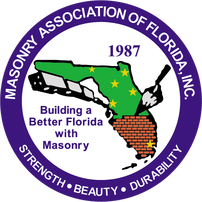|
Question: We are a residential engineering and design company in Central Florida, and have several builders inquiring about removing as many grouted filled cells as possible to reduce cost. They comment that we are more conservative than our competitors. We have completed our own wall calculations based on TMS 402-13 (and confirmed with NCMA software), and are comfortable with our grout filled cell spacing calculations; however, the code is less clear about filled cell requirements around openings. Some of our competitors only place a filled cell (typically with (1) vertical #5 bar) on one end of shorter window and door openings. I’ve heard several engineers cite FBC 2121.2.2.2 (see below), but of course this is only for High Velocity Hurricane Zones, and that section has several other requirements for “tie columns;” namely 2121.2.2.3 & 2121.2.2.4. In my view you can’t follow one section of the code, and ignore the others. I’ve spoken to plans examiners and inspectors, who cite Figure R606.11(1) showing reinforced filled cells on both sides and above and below openings; however, this section is prescriptive, deals with anchorage, and has unclear requirements (“Wind loads less than 30 psf,” is that design or ultimate pressure?). The most relevant code citations I can find are in R301.2.1.1, which points me to FBC, Section 2107: Allowable Strength Design, which references back to TMS 402-13. I can’t find any clear-cut requirements about reinforced filled cell placement around openings. Assuming we don’t need the reinforced filled cell for the loading requirements, or buck fastening, is there a code citation, construction guide, white paper, or other source we can reference regarding filled cell requirements around openings. If not, what is your view as far as best practices or typical industry standards. Referenced code section: 2121.2.2.2 When openings are between 3 and 8 feet (914 mm and 2.4 m) in width, such openings shall have one #5 vertical reinforcing bar at each side. The vertical bars shall be placed in concrete filled cells and shall extend into footings and into tie beams. All such bars shall be continuous from footing to tie beam. All splices, where needed, shall be 30 inches (762 mm) minimum. 2121.2.2.3 Tie columns shall be not less than 12 inches (305 mm) in width. Tie columns having an unbraced height not exceeding 15 feet (4.6 m) shall be not less in thickness than the wall or less than a nominal 8 inches (203 mm), and, where exceeding 15 feet (4.6 m) in unbraced height, shall be not less in thickness than 12 inches (305 mm). The unbraced height shall be taken at the point of positive lateral support in the direction of consideration or the column may be designed to resist applicable lateral loads based on rational analysis. 2121.2.2.4 Tie columns shall be reinforced with not less than four #5 vertical bars for 8 inch by 12 inch (203 mm by 305 mm) columns nor less than four #6 vertical bars for 12 inch by 12 inch (305 mm by 305 mm) columns nor less reinforcing steel than 0.01 of the cross-sectional area for columns of other dimension nor less than may be required to resist axial loads or bending forces. Vertical reinforcing shall be doweled to the footing and splices shall be lapped 30 bar diameters. Columns shall be tied with #2 hoops spaced not more than 12 inches (305 mm) apart. Great question: Short answer - up to the registered engineer or architect - not specifically addressed in any code that would usurp the judgement of the design professional....period.
Longer Answer: Lets start with section 2121 of the 6th Edition FBC - Building. These are historic prescriptive requirements and there has ALWAYS been confusion as to where and how they apply. Thus, we (the industry) inserted the following section into 2122 - Reinforced Unit Masonry - to try and drive home that 2121 just does not apply to masonry designed in accordance with the provisions of TMS 402/602: 2122.1Standards. The provisions of TMS 402/ACI 530/ASCE 5 and TMS 602/ACI 530.1/ASCE 6 are hereby adopted as a minimum for the design and construction of reinforced unit masonry. In addition to TMS 402/ACI 530/ASCE 5 and TMS 602/ACI 530.1/ASCE 6, reinforced unit masonry structures shall comply with Sections 2122.2 through 2122.10. 2122.2General. 2122.2.1 Section 2121 shall not apply where design and construction are in accordance with the provisions of this section. Thus you are completely correct that the provisions of 2121 are unique and independent and offer no guidance in properly designing your masonry structure - unless you want to use them in their entirety in designing your structure. Ok, now to the residential code. Not much help there. As you indicated, Figure R606.11(1) shows some interesting stuff but nothing that gives you the guidance you, as a designer, are looking for. The provisions calling for steel girding all openings is a seismic provision dealing primarily with shear. For shear in residential wind design you are generally going to distribute your shear to solid wall sections depending on their stiffness and utilizing only the un-reinforced value of masonry. If your un-reinforced shear value of the individual solid panels is not sufficient and you have to design a reinforced masonry shear wall you would generally be reinforcing around all sides of openings --- but --- that is almost never going to be the case with residential design based on wind (Florida has no seismic requirements) - and is rarely the case with low-rise commercial design. Bottom line is you are generally not going to see masonry under an opening unless it is there for crack control (not structural reasons). R301.2.1.1 references the ICC 600 in which section 405.3.2 "Openings in Masonry Walls" gives some common sense guidance to put a bar on either side of openings over 6' wide and to make sure that any bars interrupted by the opening get distributed to both sides. For openings in residential structures this is about as good as it gets. For large openings you have to make sure that the wall segment on either side will take the out of plane bending load from 1/2 the opening width. Where you have a number of large openings in a row this can be challenging. Obviously, you are always going to put a bar over the opening. I always recommend placing a vertical # 5 at all corners. Although this is not a code requirement it is standard practice. I also place a vertical #5 on either side of control joints – not a code requirement either.
1 Comment
Expansion Joints (Article dated Nov 11, 2015) states: \"According to the Building Code, specifying the location of the expansion joints is the responsibility of the designer (usually the Architect) ,,,,,,,\" The architect is requiring TMC to provide Expansion Joint layout, after reviewing the documents we are not comfortable providing this information and we're hoping we could get the Building Code number so we can reference it in our response to the design team. Since you are asking about expansion joints you must be talking about brick veneer. Expansion joints are located in clay masonry and control joints are located in cmu masonry. The only reference to expansion joints in brick veneers in TMS 402-16 is on page C-188 in Chapter 12 on Veneers. Section 12.2.2.11 states that in Seismic Design Categories C & D veneers should be isolated at the top and sides but doesn't give any dimensions. Before you enter into a discussion you SHOULD read the Forward to Specification Checklists on page S-83 of TMS602-16. These Checklists are no longer a part of TMS 602 but are provided to assist the Architect/Engineer in their decision making process to make sure nothing is left out of the project documents. In the Mandatory Requirements Checklist in Part 3 section3.3 D.6 the A/E is required to "indicate the type and location of movement joints on the project drawings. There is additional information available for the A/E in BIA Tech Notes on the subject. Expansion joints have specific reasons for being located properly. Do not allow the locations of these joints to be put upon the masonry contractor. sometime an A/E will put in something like "expansion joints shall not be located more than 25' apart". What that tells me is they do not understand the reasons and proper locations of expansion joints. :-) if they say something like that tell them then you will put them where ever you choose whether they work or not.. Do not let it get into your subcontract because you will be responsible for any cracks that show up. Jerry Painter, FASTM [email protected] How big can a but joint be in face brick on wood studs? How much of a variance can there be in but joint sizes with tumbled brick? I believe I am seeing two completely different questions. one is in regard to the material that will used as the substrate in your wall assembly. You will need to contact your local building department to solve the issue of fire-treated vs non combustible plywood. As far as staples in gypsum board, that method should not be used. Adhered veneer is supported by the substrate it is applied to thru the lath and the anchors used to attach the lath. I am attaching a couple of items that will give you direction on the assembly. One item to read is ASTM C1780 Standard Practice for Installation for Adhered Manufactured Stone Masonry Veneer. Even though this Practice does not include thin brick, the substrate preparation is relatively the same. Another document is BIA Tech Note 28c for Thin Brick Veneers. It is an excellent reference document. If you know the brick and its manufacturer additional information technical information is generally available on their website. I hope this is helpful in designing and constructing a beautiful and functional thin brick. Jerry Painter, FASTM Links to additional information:
BIA TECHNICAL NOTES on Brick Construction - Thin Brick Veneer 28C See also: ASTM C1780 - Standard Practice for Installation Methods for Adhered Manufactured Stone Masonry Veneer During the Masonry Workshop I attended, there was a mention of a website where you could get AutoCad details of for masonry. What was that website? A good source of details is the National Concrete Masonry Association's (NCMA) website. Other websites that offer good information on masonry construction details is the International Masonry Association (IMI) and the Masonry Contractor's Association of America (MCAA). For Clay Masonry you want to visit the Brick Industry Association's (BIA) website. On the NCMA's website the details and the NCMA TEK notes (another great source of info) are housed under the "Solution Center" button. All of these websites are great sources of masonry details and Info. Links to additional information:
https://ncma.org/ https://www.masoncontractors.org/ http://imiweb.org/ http://www.gobrick.com/ |
Authors:

Categories
All
Archives
May 2024
|
Masonry Resources |
MAF Websites |
Masonry Association of Florida, Inc. |PO Box 24474 , Fort Lauderdale, FL 33307
Copyright © 2017. All Rights Reserved.
Sitemap
Sitemap

 RSS Feed
RSS Feed
